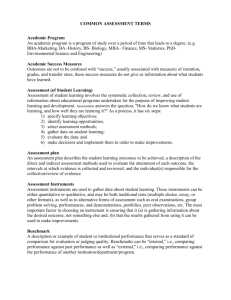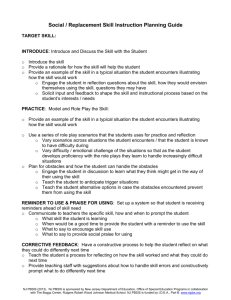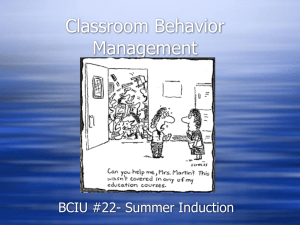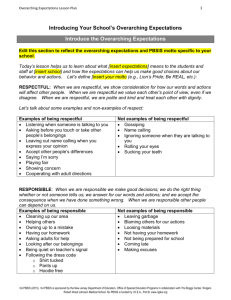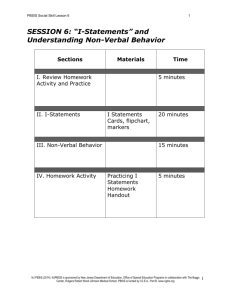Listen - Njpbs.org
advertisement
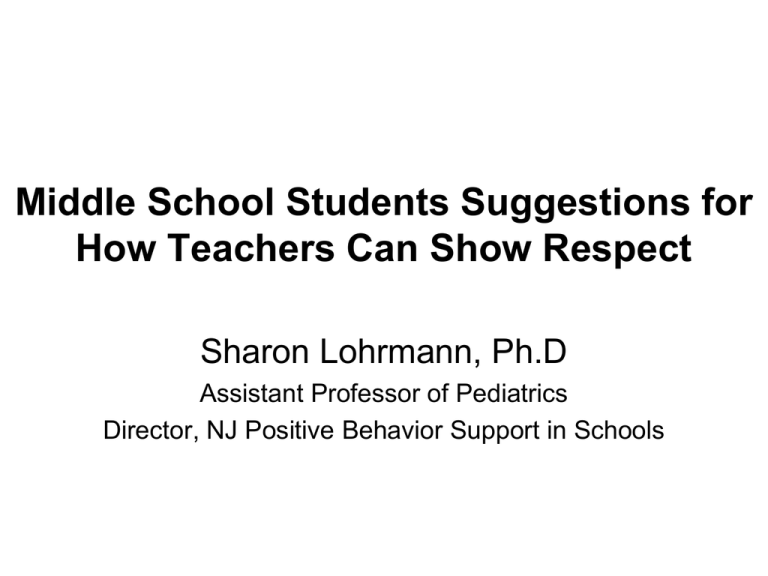
Middle School Students Suggestions for How Teachers Can Show Respect Sharon Lohrmann, Ph.D Assistant Professor of Pediatrics Director, NJ Positive Behavior Support in Schools Session Agenda • Background and context for the survey • Description of the analysis methods & results • Share NJPBSIS’s favorite strategies for getting students involved in PBIS activities Research Team • Sharon Lohrmann, Ph.D • Sunne-Ryse Smith, Psy.D • Scott McMahon, M.S.W The PBSIS Initiative: • Is a partnership with and funded by the NJ Office of Special Education Programs • The primary focus is on building capacity to support students with disabilities in general education programs PBSIS Website Directions • www.njpbs.org • Select the Resources tab – Page opens to the School-wide planning resources tab – Select the Individual Student Planning tab at the top • You are able to save all documents to your computers or flash drive Motivation for This Beginning Line of Research What Factors Lead to Positive Outcomes for Students? • The big questions we all ask ourselves: – How can schools organize themselves to promote positive academic and social outcomes? – What can staff do individually to promote positive academic and social outcomes? What Do You Think? • According to a substantial body of research, these are consistent predictors of academic achievement and positive social behaviors: • Positive teacher-student relationships • Supportive teacher behaviors (e.g., showing care and regard) • Positive peer relationships Just a Couple Examples of the Impact of Positive Teacher Relationships • Students are more likely to be resilient to risk factors when they perceive having supportive teachers (e.g., Loukas & Robinson, 2004) • Students are less likely to be truant, develop depressive systems, or engage in antisocial behaviors (e.g., Roeser & Eccles, 1998) • Children who experience conflicts with teachers in kindergarten are more likely to have negative behavior outcomes by eighth grade (Hamre & Pianta, 2001) The Interpretation of Research on Supportive Teacher Behaviors: • The relationships we have with students and the environments that we create are more influential than any other competing factors in helping students to have successful outcomes Examples of Socially Supportive School Environments • Encourage positive relationships between students and adults • Encourage positive interactions between students • Display caring • Create forums for students to be heard • Provide lots of social praise • Have clear expectations and routines • Provide help, support, and intervention quickly But Unfortunately, • Students’ perception of positive teacher relationships decrease as the student gets older (e.g., Lynch & Cicchetti, 1997) • Translation… – Students perceive having less of one of the most important factors that contribute to successful school outcomes Motivation for This Beginning Line of Research • As a researcher AND as a practitioner I have deep interest in understanding the experience of positive behavior support from the perspective of students and staff – I want to understand the first hand point of view of what students need, what students want, and how PBIS is impacting their life. Motivation for This Beginning Line of Research • Few empirically documented descriptions of first hand accounts or point of view with issues related to implementation of schoolwide positive behavior support • Qualitative studies on school climate: Research Motivation • Current Study: What can we LEARN about creating socially supportive environments by listening to what students have to say? • In the Future: how we take what we’re learning and connect it to the SWPBS process Study Research Question • To understand from the students’ point of view what explicit teacher behaviors students nominate as important to showing students respect Research Methods Background on the Student Survey • About 5 years ago, NJPBSIS began having schools implement a comprehensive self-assessment of climate & behavior priorities prior to implementing PBIS • The self-assessment includes: – Surveys of parents, staff, and students – Walkthrough of the building using a guided scoring guide Background on the Student Survey • The Universal Team summarizes the data collected from surveys into top priorities • Summaries of the assessment are presented to the school community (e.g., presentations, posting on cable stations, newsletters, etc.) • The Universal Team goes on to use the data to support universal intervention decision making Background on the Student Survey • The survey was developed by: – Reviewing the literature on school climate & SWPBS – Piloting the survey with an initial group of 10 schools – “Tweaking” and adjusting based on response patterns Background on the Student Survey • To date, the staff, parent, and student surveys have been implemented with: – – – – 24 - Elementary schools (starting at 3rd gr) 21 - Middle Schools 5 - K-8 school 7 - High Schools • However, we have not conducted a psychometric analysis of the survey The Student Survey – A Closer Look • 10 questions rated on a three point likert scale that ask about school climate related topics • Rate on a three point likert scale the extent to which behaviors and building locations are problematic • 1 open ended question: “What are three things your teachers can do to show you respect?” Survey Items Agree Not Sure Disagree My school is a positive and welcoming place I feel safe at school I feel safe on my way to school and on my way home Teachers help me when I am having trouble I can go to staff and teachers at my school if I need help I think all teachers expect the same behavior from all students Sometimes it’s hard to follow the school rules because of pressure from peers Students at this school are all treated fairly My teachers encourage students to do their best Teachers care about student opinions This part of the survey was not used in the current study What student behaviors do you think are the biggest problem at the school? Very Big Problem Sort of a Problem Not Really a Problem Gossiping Bullying or teasing one another Fighting Vandalism (e.g., writing on the walls) Disrespectful behavior or language toward students This part of the survey was not used in the current study Cutting class or detention Disrespectful behavior or language toward adults Bringing banned items (cell phones, CD players) to school Late to class or school Disruption What locations do you think are the biggest problem in the school? Hallways/stairwells Bathrooms Boys Cafeteria Classrooms Gym/Locker Room School Grounds/Bus Dismissal Area Girls (Circle) Very Big Problem Sort of a Problem Not Really a Problem The Student Survey – Procedures • School staff administered the survey • All students present on the day of survey had an opportunity to participate • Students completed the survey online • Students needing translation received ESL support – Spanish version of the survey is available. Research Data • ONLY the data from the open ended question: “What are three things your teachers can do to show you respect?” are being presented today and submitted for publication Data Source Limitations • At the time the surveys were administered information about individual respondents was not available – so only profiles of the schools are presented • However, schools had an average of a 96% response rate, so the profiles are a pretty good indication of the respondent profile School & Participant Description N= 3,692 Respondents Characteristics Attendance and Discipline Attendance Rate Mobility Rate Suspension Rate School 1 School 2 School 3 School 4 School 5 (n=802) (n=718) (n=688) (n=749) (n=742) Mean (n=738) 97.5% 2.8% 10% 95.5% 6.5% 16% 95% 35.2% 10% 94.3% 15.8% 4% 94.9% 14.10% 15% Percentage of Students Who Qualify for Free & Reduced Lunch Ethnicity Asian African - American Caucasian Hispanic Other Gender Males Females 9.7% 37.4% 61.1% 49.9% 33.8% 96% 14% 11% (State M= 5%) 38% 499 96 158 20 29 27 218 274 197 2 13 279 132 227 29 86 62 271 330 0 105 108 233 237 59 146 153 214 202 24 402 400 388 330 337 352 370 379 375 367 374 365 Benchmarks of Quality Score (pre-implementation of universal interventions) 25% 15% 18% 49% 11% 24% Methods Overview • Multi-phase consensual agreement coding process (Hill, Thompson, & Nutt-Williams, 1997; Lohrmann et al., 2008) • Comments were reviewed to ensure each comment contained a discrete idea – Total of 9,599 individual comments – On average each school contributed 20% of the data set (r=17%-24%) Consensual Agreement Coding Process • Open coding of all comments by a primary coder (Strauss & Corbin, 1990) • A second coder conducted an audit • Disagreements were tagged and discussed until consensus agreed • An initial definition list was developed • Ongoing the process was repeated and the codes and definition list adjusted through the consensus process Sample from a Coded Data Set Schl Code 2 listen to our problems 2 listen to our problems 2 listen to our problems 2 2 2 listen to our problems listen to our problems listen to our problems 2 listen to our problems Student Comment they can listen to the students when they have problems listen to a student problem. letting students come to teachers for problems,instead of teachers trying to get in to the situation. listen to the student's problems Listen to the student's questions or problems. listen to my problems if a student has to talk to someone or to the nurse because it can be serious sometimes and the might have a really bad problem and need to talk to someone really bad like from a bully, family and peer presure. Data Analysis Phase 1 • Purpose: organize data into meaningful domains and categories • Through team discussion, data were organized into overarching domains and categories • A data trail was maintained so all data could be traced back to the original source Data Analysis Phase 2 • Purpose: questioning and challenging 1. the meaningfulness of the domains; 2. the organization of emerging sub-themes (categories) within domain areas; and 3. the association of domains and categories with one another Data Analysis Phase 2 Three Steps: 1. A quantitative summary of totals and percentages of the domains, emerging categories, and codes in table and graph form 2. Individual reflection by team members 3. Team discussions promote reflection, questioning, and consensus using the constant comparative method (Bogdan & Biklen, 1992) and the quantitative summary Results Big Ideas About the Findings • There was a great deal of emotional ‘tone’ in the comments • Students took the task seriously – Other: 423 comments we couldn’t code – Very little “junk” – 23 comments total Big Ideas About the Findings • Themes are highly reflective of research findings in school climate research that look at predictors of outcomes • The big idea is that overwhelmingly, students nominate behaviors of social support as the most important things a teacher can do to show respect Students Expressed Their Ideas in Three Types of Comments • The largest bulk of comments simply labeled something they wanted the teacher to do • “Stop yelling at us” • Some gave an example of what they meant – “Teacher should talk to the student if we do something wrong instead of screaming at them like most of the teachers do” Students Expressed Their Ideas in Three Types of Comments • A few comments in each domain provided a rationale for why it was important – these comments tended to be the most insightful look into what students were trying to say: – “Generally, teachers have a habit of yelling despite the fact that all students can perfectly hear him or her. Yelling increases a student's frustration and discourages him or her to work to the best of his ability.” Findings Organizer Students want teachers to: Categories Treat them with dignity by: •Being nice •Respecting student’s privacy & maturity •Not being mean 24% •Personally investing in students’ well being •Providing acknowledgement & praise 18% •Listening •Appreciating what students have to say 15% Care about them Listen Help solve their •Being helpful •Being responsive to the need for help problems % of the Data Set 14% •Being in tune with students’ need for help Make environments positive by: •Creating a positive learning atmosphere •Lightening students’ workload •Treating everyone the same Level the playing field by: •Not picking favorites •Paying attention to each student •Not judging students 14% 7% Students Want to be Treated with Dignity (24%) • “One important thing a teacher can do to show respect to students is by treating us very nicely.” • Be nice – Be Nice, friendly, kind – Tone of voice, word choice, & context of interaction – Warm greetings & polite interactions Students Want to be Treated with Dignity • “Teachers can have more respect for us by not treating us like we are four years old.” • “A teacher can trust a student to do the right thing when not supervised.” • Respect students’ maturity and privacy – – – – Respect students privacy and personal space Regard students as mature Treat students as you want to be treated Trust students and be honest with them Students Want to be Treated with Dignity • “Teachers can show students respect by not being unnecessarily mean or showing their anger on us.” • “Stop YELLING. It makes some children feel small. And they feel bad and upset.” Students Want to be Treated with Dignity • Don’t be mean – Don’t ridicule, embarrass, pick on, be sarcastic, make fun of students – Don’t Yell or get mad at students – Don’t put students on the spot – Don’t punish the whole class, for something one or a few students did – Make sure there’s a really good reason when you remove a student from class – Don’t blame or accuse, listen to the student’s side or get more facts Students Want to be Cared About (18%) • Personally invest in students well being – Be Understanding – Care about students – Listen to and be interested in students’ problems • The tone of the comments really reflected the need for being nurtured & personal connections Students Want to be Cared About - Examples • “Respectful teachers have personal connections with students” • “Respectful teachers stand up for us” • “I wish teachers would really listen to our problems because some teachers act like they do not care” • “One thing a teacher can do to show us respect is to understand our situation and to know what we go through in everyday life” Students Want to be Cared About • 8% of the entire data set reflected the idea of acknowledgement & social praise: – “Acknowledge their participation in class. If the student shares something inspiring the teacher should definitely appreciate the insight. Most students feel more selfconfident when an adult appreciates their thoughts.” Listen to what students have to say (15%) • Listen – Listen to what students have to say – Use good listening behavior (e.g., make eye contact, focus, don’t interrupt) when a student is talking – “Teachers should give students a chance to explain things such as why they didn’t do homework because if they shut them down they won’t open up if they need help and it will weaken the relationship which will lead to a bad learning experience.” Listen to what students have to say (15%) • Appreciate what students have to say – Care about students’ opinions, answers, comments – Give students a chance to express their opinion – Be open-minded to students’ suggestions or point of view – Take actions on students’ opinions – Answers students’ questions Listen to what students have to say (15%) – “They could ask us more about rules and things that could make the school a better environment.” – “Use one of my ideas to help class be more fun.” – “Allow all students to have voice in the classroom.” Students Want Help Solving Their Problems (14%) • Be helpful; Responsive to the need for help; be in tune with student’s need for help – Be helpful with school, home, and social issues – Be responsive when students ask for help – Reach out and offer help when you see a student having trouble – Attend to signs that students are having difficulty Students Want Help Solving Their Problems • “Guide them through the worst times” • “Teachers should help a child who is not fitting in.” • “Ask kids if they need help and not say come to me if you need help because sometimes kids will not come to you because of their friends and peer pressure of other kids.” Make the Learning Environment Positive (14%) • Create a positive learning atmosphere – – – – – – – – – – – – – Be a good teacher Be positive (fun friendly) Make students feel welcomed Call on all the students (not just a couple) Vary instructional methods Make learning fun Don’t pressure students Teachers should follow the rules just like students Pay attention to misbehavior (especially in the halls) Explain things clearly so everyone understands Check for understanding Let us know how we are doing Give us a chance to improve our grades Make the Learning Environment Positive (14%) • “Teachers can be respectful by coming to school with a good attitude.” • “One thing that a teacher could do to show a student respect is welcoming them.” • “Teachers should work hard to make sure that no child is having a difficult time during class. This is important because people may feel uncomfortable with participating in class.” Make the Learning Environment Positive (14%) • “Make students feel accepted and not left out, especially in group activities.” • “Teachers can help the students learn easily what they need to learn by keeping everyone one on track by making sure they aren’t bored. Kids do not pay attention when they are bored and when things get fun the kids learn more easily and can do better in school.” Make the Learning Environment Positive • Reduce the workload: The main themes in this category revolved around: – Give less homework* – Coordinate work across teachers – Give enough time for us to do our work – Make work easier Make the Learning Environment Positive • “Homework is a nuisance because it adds stress to the daily life of a student. Most students are not known for doing well under pressure.” • “They can give us less homework so we have more time to study and improve on other things instead of learning something new every day and forgetting them and in my opinion that is how teachers can show us respect.” • “All of the teachers should get together and talk about what they were planning to teach in class that day, what homework they were going to assign, and what tests they were going to give so that students don't have to study for 5 different tests all in one night.” Level the playing field (7%) • Overarching idea is that teachers should treat students equitably • Concern over preferential & differential treatment: – Treat everyone the same – Don’t pick favorites – Pay attention to each student – Don’t judge students on past mistakes, how they look or what you’ve heard Level the playing field • “Teachers shouldn’t favor students because it makes other kids feel left out.” • “Teachers shouldn’t ostracize a student because of past misdeeds.” • “The teacher should treat all students fairly. Just because a student is the same culture as the teacher the teacher can’t treat them better than someone that is not the same culture.” Switching Gears: From Research to Practical Application Schools Incorporate Comments into Their Discussions with Staff • Remember the survey is part of a school’s self assessment • After schools conduct the surveys – they summarize the results & present to the school community: – Presentations at staff meetings – Assemblies with students – Postings on cable stations – Summaries in newsletters Schools Incorporate Comments into Their Discussions with Staff • The self assessment is an opportunity to engage the school community in the planning process and clearly identify planning issues that are top priority – The survey-summary strategy is a great opportunity to build buy-in among staff – The student comments in particular are an opportunity to talk with staff about the student point of view Potential Power of Student Comments • School teams are using student comments: – To facilitate focus group discussions with students – As a rationale for why a practice should be adopted – To reinforce positive things that staff are doing – As a conversation starter for planning discussion 90 High School Example of Student Comments Graphed for Presentation 80 70 60 50 40 30 20 10 0 Teach Us Care About Us Conduct Respect Listen Treat Fair Jr. High School Example of Student Comments Graphed for Presentation 1,125 Students responded Get Students Involved: Our Favorite Examples of Activities to Get Students More Involved PBIS Liaisons, Ambassadors, Peer Leaders & Clubs • PBSIS clubs • Student led instructional activities & advisory groups • Peer Leaders provide input • Focus groups for planning • PBSIS ambassadors who welcome & escort visitors during instructional & special events Material Production • Student directed videos • Student directed instruction scripts & role plays • Logo contests • Costume contests • Graphics & prop design (built into curriculum as part of course credit) Graphic Arts Incorporated Logo Design and Client Presentation into Course Student: ____________________________ Staff Member: _______________________ Our #1 Favorite! • Reverse day – Students are given a ticket that they can give to any adult in the building A Couple of New Ideas We’re About to Try • Asking “what is it like to receive a --ticket?” – Journaling ‘do now’ – School-wide journal submissions – Follow up survey with students – Focus groups

